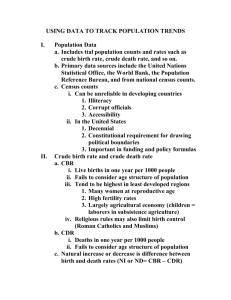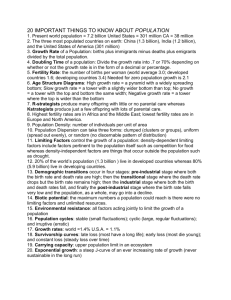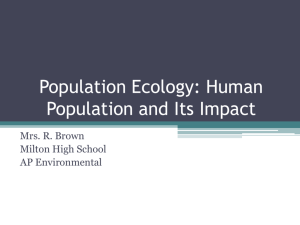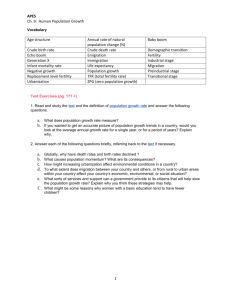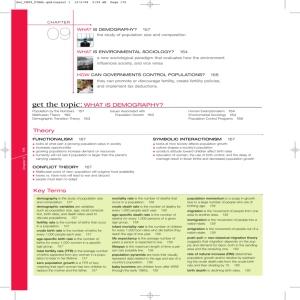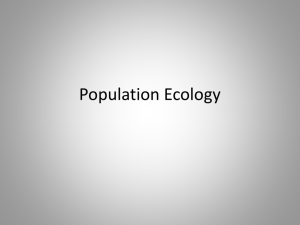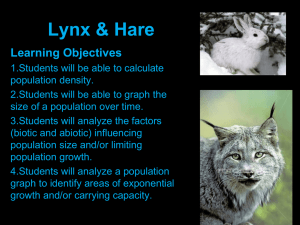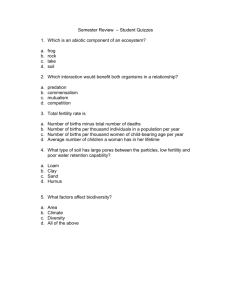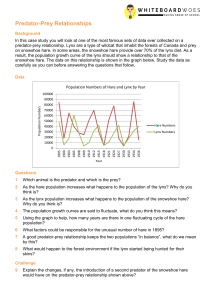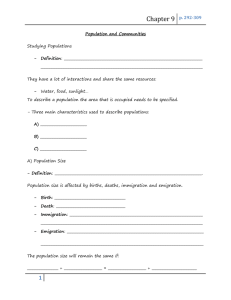Chapter 9&10 review - CarrollEnvironmentalScience
advertisement
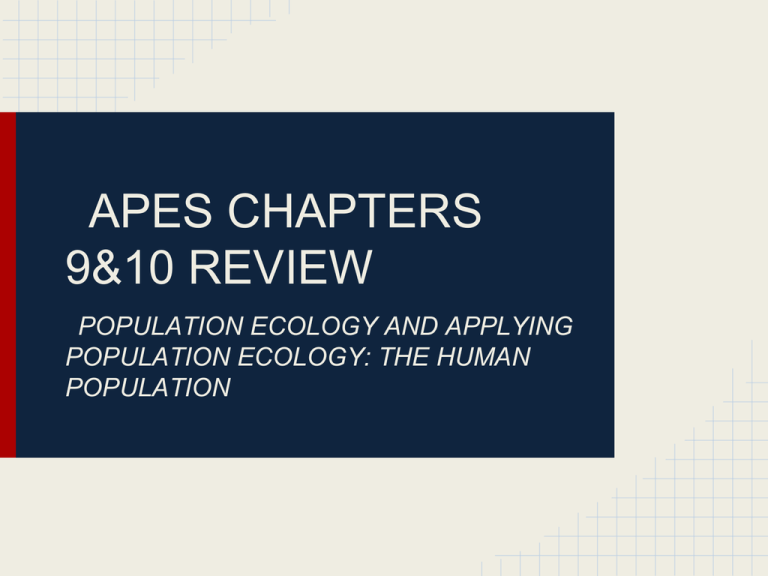
APES CHAPTERS 9&10 REVIEW POPULATION ECOLOGY AND APPLYING POPULATION ECOLOGY: THE HUMAN POPULATION CHAPTER 9 POPULATION DYNAMICS: change in size, density, and age distribution in response to environmental conditions Populations also change because of how they are distributed in their habitat. CHAPTER 9 CLUMPED: most species live in clumps. 1. resources species need vary from place to place 2. protection from predators 3. ex. wolves: better chance of getting a meal 4. groups for mating and caring for young CHAPTER 9 UNIFORM CHAPTER 9 RANDOM DISPERSION: CHAPTER 9 asdf Biotic Potential: potential for growth Environmental Resistance: all factors that limit growth Carrying Capacity: combination of the two CHAPTER 9 CHAPTER 9 LOGISTIC GROWTH CHAPTER 9 EXPONENTIAL GROWTH, OVERSHOOT, AND POPULATION CRASH CHAPTER 9 TOP DOWN CONTROL: (lynx and the hare) the lynx preys on the hare, causing a decrease in hare in return causing a decrease in the lynx population. BOTTOM UP: the changing hare population is what effects the lynx population CHAPTER 9 r selected species: (r)= roach *reproduce early *lots of offspring *little or no parental care *massive loss of offspring OPPORTUNISTS CHAPTER 9 K= kangaroo *fewer, larger offspring *high parental care *later reproductive age *larger adults *late successional species COMPETITOR CHAPTER 9 SURVIVORSHIP CURVE: early loss, late loss, and constant loss CHAPTER 9 Natural Systems: biologically diverse use renewable solar energy little if any waste production recycled nutrients net primary productivity shared among many species CHAPTER 9 Human Dominated Systems: biologically simplified mostly renewable fossil fuel energy high waste production nutrients often lost or wasted net primary productivity: used, destroyed or degraded to support human activities CHAPTER 9 WAYS THAT WE HAVE ALTERED NATURE TO FIT OUR NEEDS: degraded habitats reduced biodiversity introduced non native species wasting resources strengthened some species of pests through pesticides eliminated predators overused natural resources interfered with chemical cycling we have become dependent on non renewable CHAPTER 9 PRINCIPLES OF SUSTAINABILITY CHAPTER 10 POPULATION SIZE: THE KEY PLAYERS BIRTHS (+) IMMIGRATION(+) DEATHS(-) EMMIGRATION (-) population change = (births+immigration)(deaths+emmigration) CHAPTER 10 CRUDE BIRTH RATE: number of live births per 1000 people in a population in a given year CRUDE DEATH RATE: number of deaths per 1000 people in a population in a given year CHAPTER 10 ANNUAL RATE OF NATURAL POPULATION CHANGE= (BIRTH RATE-DEATH RATE)/1000 x100 (BIRTH RATE-DEATH RATE)/10 CHAPTER 10 DOUBLING TIME: (aka the easiest of the math you will do on the exam) THE RULE OF 70: 70/ percentage growth rate (just the number, don't change anything) = doubling time in years CHAPTER 10 DIFFERENTIATING BETWEEN DIFFERENT TYPES OF FERTILITY: Fertility: number of births that occur to in individual woman or in a population Replacement level fertility: number of children a couple must bear to replace themselves (2.1 in developed and as high as 2.5 in developing) Total fertility rate: average number of children a woman typically has during her reproductive years (dropped sharply since 1950) CHAPTER 10 WHAT FACTORS AFFECT BIRTH RATES AND FERTILITY RATES: Importance of children as part of the work force Cost of raising and educating a child Availability of private and public pension systems Urbanization Educational and employment services for women Infant mortality rate Average age at marriage CHAPTER 10 WHY HAS THE POPULATION GROWN SO RAPIDLY? not by an increase in the birth rate, but a decrease in the crude death rate CHAPTER 10 BEST INDICATOR OF A COUNTRY'S QUALITY OF LIFE: Infant Mortality Rate a high infant mortality rate indicates insufficient food (undernutrition) , poor nutrition (malnutrition) , and a high incidence of infected drinking water CHAPTER 10 Rapid population decrease is just as dangerous as rapid population increase side effects: decreasing number of working tax payers more people on social security than those working to pay for it forced to raise retirement age, increase taxes, etc. CHAPTER 10 CAN THE WORLD PROVIDE AN ADEQUATE STANDARD OF LIVING FOR 2.5 BILLION MORE PEOPLE WITHOUT CAUSING WIDESPREAD ENVIRONMENTAL DAMAGE? CHAPTER 10 Optimum population for a country Should the amount of children you have be regulated? We fail to provide the basic necessities to live for one out of six people today CHAPTER 10 DEMOGRAPHIC TRANSITIONS Pre industrial: high birth rate and high death rate Transitional: Death rates drop, birth rates remain high Industrial: birth rates drop, death rates remain low Post Industrial: birth rates and death rates approach zero reaching zero population growth CHAPTER 10 FAMILY PLANNING IS IMPORTANT Educational services to help couples choose how many kids they want and when they want them Raised use of contraceptives in developing countries from 10% in 1960s to 51% in 2004 CHAPTER 10 WOMEN: women do almost all the worlds domestic work and child care with little or no pay Women do 60-80% of the work associated with growing food, gathering fuelwood, and hauling water in rural areas of Africa, Latin America, and Asia CHAPTER 10 EMPOWERING WOMEN=LESS BABIES More education + high paying job most likely means: less concerned with marriage and having a family more educated as concerned with family planning access to contraceptives CHAPTER 10 THE UN'S PLAN TO REDUCE POPULATION Universal family planning Improve health care for infants and women "National population policies" Expand job opportunities for women Provide more education (especially for women) Increase involvement of men in child rearing "Sharply reduce poverty" Reduce unsustainable patterns of production and consumption
